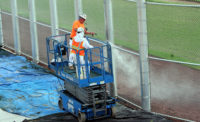One cool dawn about 20 years ago, architect Douglas Stroh sat horseback at the top of an 8-mi trail descending into the western Grand Canyon.
He’d left home in Prescott, Ariz., hours before, driving in darkness north to the trailhead near tiny Peach Springs. Though he hadn’t been on a horse since age 12, he mounted up and joined colleagues for the three-hour descent to Supai village, located 2,000 ft below the rim and home to about 500 Havasupai Indians.
Stroh wasn’t sightseeing. He was on the job, headed to a Havasupai Tribal Council meeting to discuss design of a multipurpose center. It was the first of six projects he would create for the Havasupai, and one of more than 85 for other Southwestern tribes over the next two decades.
More, it was an introduction to the somewhat alien world of construction on Indian lands.
Not all tribal projects necessitate hopping into the saddle and riding into the wild. But design and construction professionals experienced in this niche say tribal projects differ from private and government work in striking ways. They range from legal differences stemming from tribal sovereignty to intangible cultural values paramount in most projects.
One general rule: no two tribes are exactly alike.
“To generalize Indian tribes is like generalizing state governments,” says Stroh, whose tribal project experience started in the 1970s in the Dakotas, where he wrote grants and designed housing for the Great Sioux Nation. “They all have different values, different priorities, different levels of education. Generally, they’re all culturally oriented. That’s a big priority.”
Understanding that culture, government and goals are unique to each tribe is a prerequisite, but that doesn’t mean these things are easy for nontribal members to understand, says Urban Giff, former Gila River Indian Community manager in Arizona and part of the leadership for several regional and national American Indian business organizations.
“When you deal with business outside the reservation, you’re dealing with people who have no or little familiarity with what the tribe is about, who they are, their values and the principle areas they’re concerned about protecting and preserving,” says Giff, a member of the Pima Tribe who traveled extensively over 20 years as a Marine Corps officer before returning home in 1980. “Sometimes that is a disappointing experience for outsiders. They want to learn, but sometimes they don’t know what to ask, where to go, how to ask, how to go about it.”
To tackle this task, some national contractors have formed sectors dedicated to doing business with tribes. One is Tulsa, Okla.-based Flintco Cos., the largest Native American-owned construction company in the country. Its tribal projects make up about 30% of its business and include more than 65 tribes.
In addition to serving as a clearinghouse of cultural information and educating staff, Flintco’s Native American...








Post a comment to this article
Report Abusive Comment